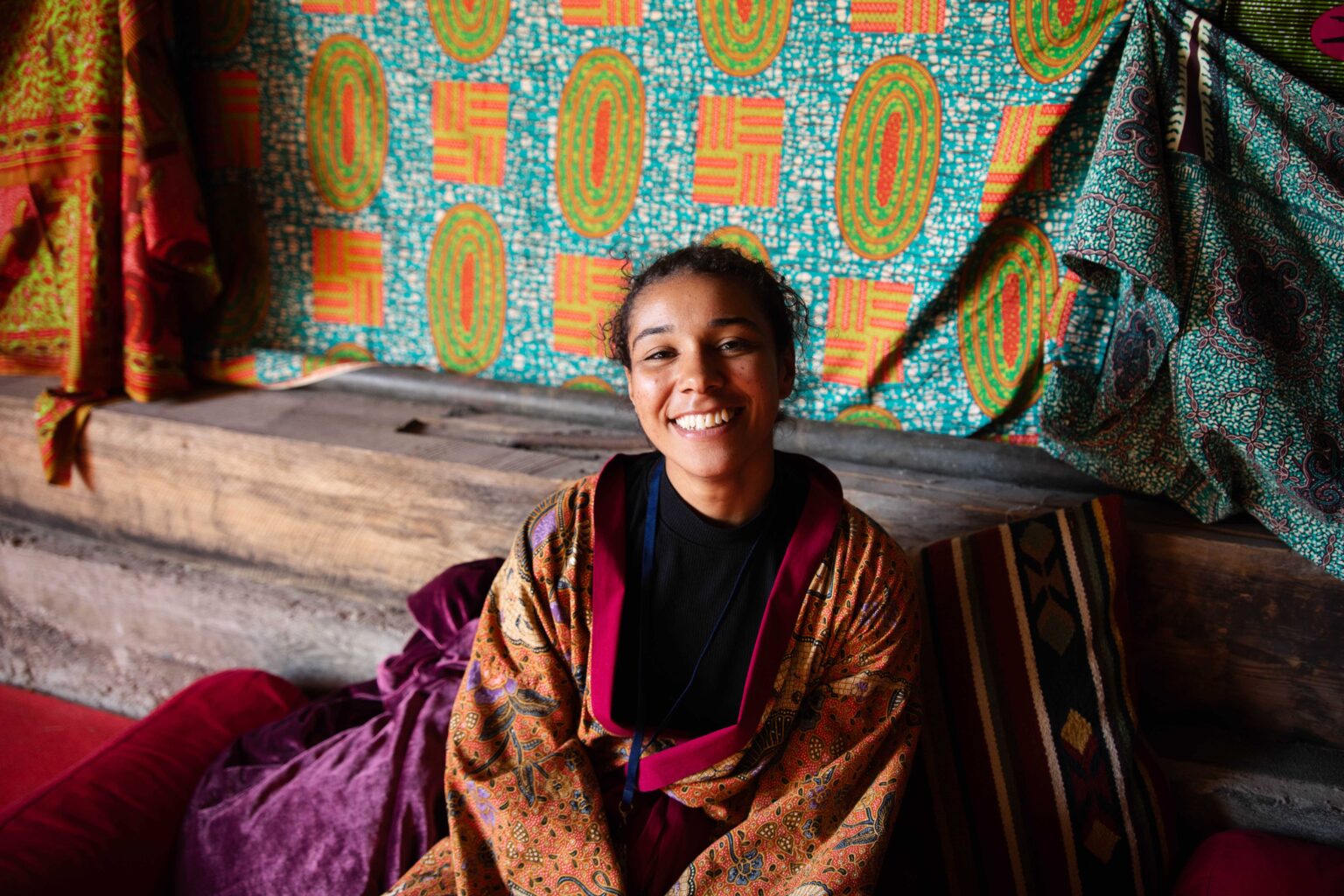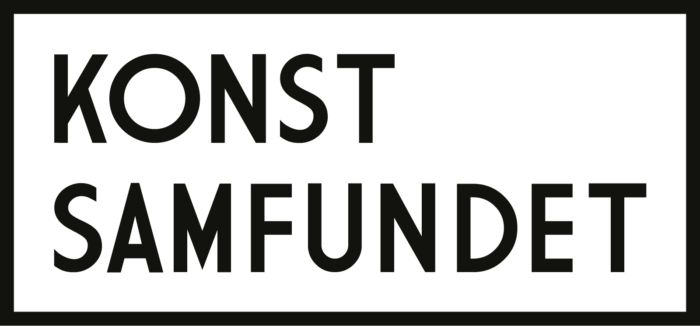
Antonia, could you share with us the background and starting point, research, and process behind Don’t thank for the Food? What inspired you to create this performative installation?
The process actually began some time ago when I started my Master’s years at the Theatre Academy in 2022. The worst part of the pandemic was over and even though it had been a tough time, it was the first time I had the time and space to take a step back and reflect. Amid the hustle of academic life, I didn’t take the time to reflect on my identity, and I realized that I had unconsciously left a large part of who I am outside the academy. I felt pressured to fit into either the white-dominated perspective of art or the constrained box of Black identity.
This tension stayed with me, but I didn’t fully grasp it until later in my studies.
It wasn’t until four years into my studies that I had my first course on representation. That was when I learned that our art has deep colonial roots. To put it into perspective, I had already spent years in the academy without being exposed to these fundamental discussions.
Around that same time, a newly arrived professor Aune Kallinen asked me, “How has it been for you, and what do you need as the only BIPOC student in your class?” Startled, I realized that this was the first time I was ever asked that question. It was at that moment I truly realized how little space there is for BIPOC identities within art institutions, and how little attention is given to our experiences in academic spaces.
During a course called Contextual Deepening (translated from Swedish Kontextuell Fördjupning) by Outi Condit, I decided to focus on my identity. My main question became: How can I work with this subject on my own terms, in a space with a predominantly white audience? I chose to approach this in a way that felt meaningful to me: through joy and community.
For the first iteration, I created a demo project where I transformed a classroom into my ”home” for a few days. I was inspired by the idea of house squatting — of becoming a ”parasite” in an institution — by claiming space in a place where I was never meant to belong. I surrounded myself with things that made me feel grounded: home videos, voice recordings, familiar colours, textures — anything that brought comfort.
But I didn’t want to be alone in this space. I invited fellow BIPOC student, Sofia Sharifi, to join me and do whatever she wanted. That collaboration sparked something deeper in me. I realized this was more than just a project — it was the beginning of something I wanted to dedicate the rest of my studies to.
So, for my final artistic work and thesis, I decided to re-create this living installation. My research question was: How can I create decolonizing art with an education shaped by a white institution?
This time, I occupied a larger student space — one with a kitchen — and pushed the idea further. I wanted to create a piece that was personal, but also collective. I envisioned an art piece that could only exist in a communal and social setting. I invited more BIPOC artists and students to contribute their own work. I reached out to reading groups, youth organizations, and BIPOC communities, inviting them to take part in the space. It became both my thesis and my final artistic expression.
As I considered what I should contribute to the space, I had a conversation with my family over dinner. I spoke about the idea of cooking Ghanaian food as a way to celebrate my heritage and the familiar smell of home. My father burst into laughter and said: “You have no clue how to cook Ghanaian food! I’ve been trying to teach you for years, but you’ve always been more interested in eating it than cooking it.”
So I asked him if he would join me in the installation to teach me how to cook. He agreed, but on one condition: that the ingredients be paid for by the school.
Since then he has been part of this installation. We reimagined the work with a lovely group for the Hangö Teaterträff theatre festival in 2024, and we are now preparing for the next phase in Moving in November.
As the host of a space aimed at providing narratives and inspirations to a BIPOC audience, how do you understand your role in this setting?
In the earlier versions I had a handful of roles. My role as a host was the director, producer, audience worker, set designer, gallerist, sound designer, light designer, the translator, contact person and food caterer. Luckily, I have had a lovely group of people working with me to help with the load. Now when I can let go of some of the roles through working with Moving in November and with Mirjam Yeboa and Katinka Ebbe, I can focus on what the host role entails.
For me I understand my role as a host as someone that aspires to bring people and art together. To facilitate a space for BIPOC audience and artists and give tools, opportunity and motivation. Since I feel that hosting this kind of space is very important – not only for others but for myself as well – I feel that this host role has the responsibility and opportunity to listen and see what is needed.
Since rest and joy are the centre elements in this piece it is also important for the host to give space for change. Nothing in this piece has to be a particular way or aggressively controlled. It lives through the community, and this means that space has to be created. With this is mean – letting go of the control and listening in, is also a big part of the role.
I’d like to see my role as someone who sets the space and has responsibility for it, that the space still feeds the need of the community and that it is accessible even though the atmosphere changes. The responsibility that the purpose of the installation stays the same.
But I also see to it, that the responsibility is somewhat shared. We all have to take responsibility, to give space, to let people rest and to encourage people to be creative.
When thinking about the stories told in our art spaces, your performative installation clearly responds to your experience of what is missing. How would you articulate your wishes and needs towards curators, theatre and museum directors, and cultural policy makers?
I read through my thesis actually last week and this was what I wrote as a finishing paragraph:
I didn’t want to get any right answers, but I feel that my question made me more aware
of structures and new issues that can take me further in a process. I would not have gained this without the extensive preparatory work and the processes that deviated from what I was accustomed to.
The rapid pace of project creation and the habit of creating on an assembly line are factors that promote what we are familiar with: white, homogeneous and Eurocentric art.
Change requires us to break not only the structures of narratives and representation, but also our way of working. Actively seeking representation and other narratives requires time and financial resources, and this is something those in power must be willing to provide. Working in an anti-racist and decolonised way means more than accepting. It is about action, giving up power, giving time and financial support. I therefore encourage institutions and individuals with power and privilege not to get stuck on words alone. Stop and look around, does your space have few or no BIPOC people at all? (no one is not enough). And in what positions are those people? Take a step back, rethink, correct. Give time, work and resources that deviate from what we are used to. Let others go first in the queue.
Through this process, I want to take the work forward not as a finished product but as an
ideology. I want to see how the work can take shape in different spaces and what new things it can promote.
The work is definitely not just a version of utopia. The work is an energy and an
approach that creates something according to our needs as BIPOC people and the needs of artists and cultural workers in general. The work listens, nurtures and creates new realities. Realities we need.
I feel that that is still the thing I want to say to our institutions.
These times are so tough and inhumane and instead of cutting down, gatekeeping, speeding up and seeing diversity, safety and wellbeing as a 30-minute quick wash program, we have to dig deeper and make different “sacrifices”. Because those sacrifices are not even sacrifices. It’s simply just letting go of old, unsustainable strategies for art and life.
Antonia Atarah: Don’t thank for the food
Caisa 7.11.2025 16.30 / 8.11.2025 14.00
Soup Talk 8.11.2025 12.00 @Caisa
Facilitator, director: Antonia Atarah
Visual artist, co-facilitation: Mirjam Yeboah
Cooks: Linus Atarah, Nana Thomson
Artists: Edit Williams, Farhia Omer, Julian Owusu, Soila Shah
Light designer: Katinka Ebbe
Collaborators: Good Hair Day, Pehmee-kollektiivi, POC-lukupiiri, Muudi
Special thanks to: 00100 Ensemble, Uniarts Helsinki Theatre Academy, Folkhälsan, Mavis Fugar, Cirko, Anna-Stina Lindholm, the BIPOC communities and organisations, everyone involved in the previous installations.
Exhibition artists: Iida Valmé, kemelo sehlapelo, Selma Mataich, Shaghayegh Ansari, Victor Miyano, Vivian WONG Wing Lam
The project started in 2022 and was the final artistic work of Antonia’s graduation at Uniarts, Helsinki. It has been shown in Hangö Teaterträff in 2024.
Photo: Emma Reijonen
Visit supported by: Konstsamfundet and Eugène, Elisabeth och Birgit Nygréns stiftelse
Visit in collaboration with: Caisa

